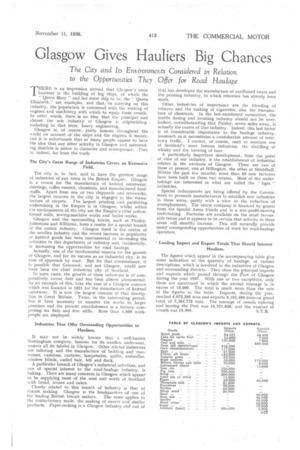Glasgow Gives Hauliers Big Chances
Page 149

If you've noticed an error in this article please click here to report it so we can fix it.
The City and Its Environments Considered in Relation to the Opportunities They Offer for Road Haulage
HERE is an impression abroad that Glasgow s main business is the building of big ships, of which the " Queen Mary " and her sister ship to be. the Queen Elizabeth," are examples, and .that, in carrying on this industry, .the liopulation is concerned with the making of engines and machinery with which to equip these vessels. In other words, there is an idea that the principal and almost the solo industry of Glasgow is shipbuilding, including in that term, heavy engineering.
Glasgow is, of course, justly famous throughout the world on account of the ships and the engines it makes, but it is unfortunate that so many people appear to have the idea that any other activity in Glasgow and surrounding districts is minor in character and consequence. That is, indeed, far from the truth.
The City's Great Range of Industries Covers an Extensive Field.
The city is, in fact, said to have the greatest range of industries of any town in the British Empire. Glasgow is a centre for the manufacture of knitted outerwear, shirtings, coffee essence, chemicals, and manufactured foodstuffs. Apart from one or two shipyards and ironworks, the largest concern in the city is engaged in the manufacture of carpets. The largest printing and publishing undertaking in the Empire is in Glasgow, whilst within the environments of the city are the Empire's chief cottonthread mills, sewing-machine works and boiler works.
Glasgow and the surrounding .towns, such as Paisley, Johnstone and Kilbirnie, form a centre for a special branch of the cotton industry. Glasgow itself is the centre of the woollen industry and the recent increase in popularity• of knitted goods has been instrumental in increasing the activities in this department of industry and, incidentally, in increasing the opportunities for road haulage.
Actually, one of the fundamental reasons for the growth of Glasgow, and for its success as an industrial city, is its ease of approach by road. But for that circumstance, it is possible that Greenock, and not Glasgow, would now have been the chief industrial city of Scotland,
In some cases, the growth of these industries is of comparatively recent date and has been almost phenomenal. As an example of this, take the case of a Glasgow concern which was founded in 1921 for the manufacture of knitted outerwear. It is now the largest concern of that description in Great Britain. Twice, in the intervening period, has it been necessary to transfer the works to larger premises and the present establishment is a factory comprising six fiats and five Wills. More than '1,500 workpeople are employed.
Industries That Offer Outstanding Opportunities to Hauliers.
It may not be widely known that a well-known Nottingham company, famous for its woollen underwear, weaves all its fabrics in Glasgow. Other related industries are tailoring and the manufacture of bedding and mattresses, cushions, curtains, lampshades, quilts, umbrellas, window blinds, curled hair, felt and flock.
A particular branch of Glasgow's industrial activities, and one of special interest to the road-haulage industry, is baking. There are many concerns in Glasgow which appear to be supplying most of the west and north of Scotland with bread, scones and cakes.
Closely related to this branch of industry is that of biscuit making. Glasgow is the headquarters of one of
the leading British biscuit makers. The same applies to the confectionery trade, the making of sweets and similar products. Paper-making is a Glasgow industry and out of
that has developed the manufacture of cardboard boxes and the printing industry, to which reference has already been made.
Other industries of importance are the blending of tobacco and the making of cigarettes, also the manufacture of chemicals. In the last-mentioned connection, the textile dyeing and finishing industry should not be overlooked, notwithstanding that Paisley, seven miles away, is actually the centre of that industry. Indeed, this last factor is of considerable importance to the haulage industry, inasmuch as it necessitates a considerable amount of intertown traffic, I cannot, of course, omit to mention one of Scotland's most famous industries, the distilling of whisky and the brewing of beer, A particularly important development, from the point of view of our industry, is the establishment of industrial estates in the environs of Glasgow. There are two of these at present, one at Hillington, the other at Shieldhall. Within the past few months, more than 50 new factories have been built on these two estates. Most of the undertakings are interested in what are called the " light " industries.
Special inducements a.,re being offered by the Government to persuade manufacturers to establish new industries in these areas, partly with a view to the reduction of unemployment. The estate company is financed by grants from the Speccal Areas Funds and is a non-profit-earning undertaking. Factories are available on the most favourable terms and it appears to be certain that activity in these areas will steadily increase. This will naturally provide many corresponding opportunities of work for road-haulage operators.
' Leading Import and Export Totals That Should Interest Hauliers.
The figures which appear in the accompanying table give some indication of the quantity of haulage, of various descriptions, which is involved in the industries of Glasgow and surrounding districts. They show the principal imports and exports which passed through the Port of Glasgow during the year 1937. With one or two exceptions, only those are mentioned in which the annual tonnage is in excess of 10,000. The total is much more than the sum of the figures in the table. Imports, during the year, reached 4,072,295 tons and exports 8,192,480 tons—a grand total of 7,264,775 tons. The tonnage of vessels entering and leaving the Port was 15,721,920, and the number of
vesselg was 13,390. S.T.R.




























































































































































